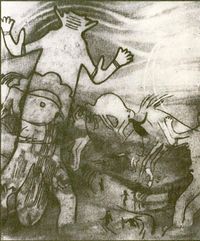UnNews:'E.T.s visited ancient Earth' proof discovered
7 March 2009

HAMPSHIRE, U.K. -- The 'alien astronaut' hypothesis is nothing new - many readers will be familiar with the idea since it was popularised by Swiss researcher Erich von Däniken in his series of books during the 1970s and 80s, in which he offered several arguments and apparent photographic proof that highly-intelligent aliens had visited the planet Earth in ancient times and influenced the formation of early religious beliefs. Von Däniken found many supporters along the way and his first book - Chariots of the Gods (1968) - sold well, making it onto best-seller lists in many countries and was profitable enough to allow him to both concentrate on writing a series of books on the subject and to give up his tendency toward tax evasion and fraud. He developed the ideas further, eventually coming to the conclusion that these ancient aliens had in fact taken an active part in Early Man's cultural and biological development, even to the extent of genetic modification.
However, despite their popularity amongst the non-scientific community, his theories - widely and incorrectly known as astroarchaeology or archaeoastronomy - have been extensively debunked by other writers and real scientists, most notably Ronald Story in The Space Gods Revealed, (1976). Even writers who believed that von Däniken's theories may have some grounding in truth claimed that such an extraordinary hypothesis demanded extraordinary proof and that von Däniken had not provided such proof, merely a number of grainy photographs of artifacts created by ancient people known to have consumed large quantities of wild mushrooms in the days before there were any guidebooks advising one whether they were safe to eat or not.
Those detractors will be eating their words along with their cornflakes this morning, just before they flock to grovel at the Swiss author's feet and beg for forgiveness, because incredible and incontrivertible proof that ancient societies received visitors from the stars has now been found, completely by chance, in a pond near Beaulieu in Hampshire, United Kingdom. A group of environmental protection workers was clearing a rubbish-filled pond when volunteer Marc Cokehead found an incredible artifact completely by chance. "We'd already dragged quite a bit of rubbish from the pond," Marc told reporters, "an old pool table, shopping trolleys, a couple of sacks filled with unidentifiable bones - the usual sort of stuff we expect to find when carrying out a pond clearance. I was raking the bottom of the pond to drag up discarded bottles and cans and must have dislodged the artifact, because it suddenly floated to the surface. It was eerie - it must have been down there for millennia and all of a sudden there it was, staring right back at me. I felt I'd come face-to-face with an alien."

Scientists have been unable to accurately date the artifact. Professor Thomas Oldefart, of Cambridge University, says, "We are carrying out a number of tests on the object to determine its age and providence. We're not helped by the fact that it appears to be inorganic - by which I mean that the lifeform from which it comes was not carbon-based - and so our standard carbon dating techniques are not viable. We have, meanwhile, managed to recover quite a large selection of organic particles such as pollen grain and seeds that had become lodged within it, presumably after it found its way into the pond, and hope that these will give us some clue as to its antiquity. The trouble is that the pond has three small streams running into it, so there are fairly strong currents in there, and these particles could have been washed into the artifact at any time."
Other techniques such as obsidian hydration analysis (OHA) are not applicable either, as the region does not have the correct geological make-up. Prof. Oldefart remains hopeful that another technique - varve analysis, in which local sediments are studied in order to date the layer within which an artifact is located - may be of some use, but cautions that an accurate dating will be impossible in this case since the pond bed sediments will have been extensively disturbed by the raking. "We may be able to date it to within a thousand years or so," says Dr. Ivor Peeaichedee of Oxford University. "My team was provided with a sample drilled from the mud underneath the pond and we will report any findings as and when we make them. I'm willing to say that, based on what we know thus far, the artifact is somewhere around 10,000 years old. This would mean that Ancient Britain was visited by intelligent beings from outer space in the late Mesolithic period, before the construction of Stonehenge."
Von Däniken, now 73, is said to be taking an active interest in the findings from his home in Interlaken, Switzerland - where his ill-fated Mystery theme park closed down in 2006 due to lack of interest and because, according to at least one visitor, "it was crap." In an exclusive interview with UnNews, we asked him if he had any message to the scientific establishment that has mocked him and his paleo-contact theories for so many years. "Yes," he said. "Suck it, bitches."
Sources[edit | edit source]
- "Dr Who Dalek found in pond" Telegraph.co.uk, March 04, 2009